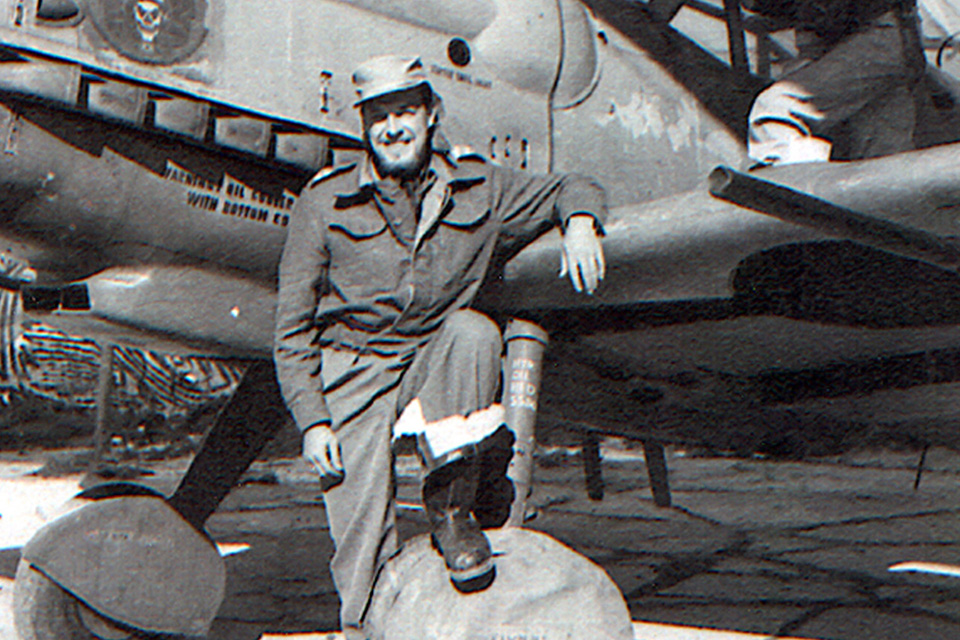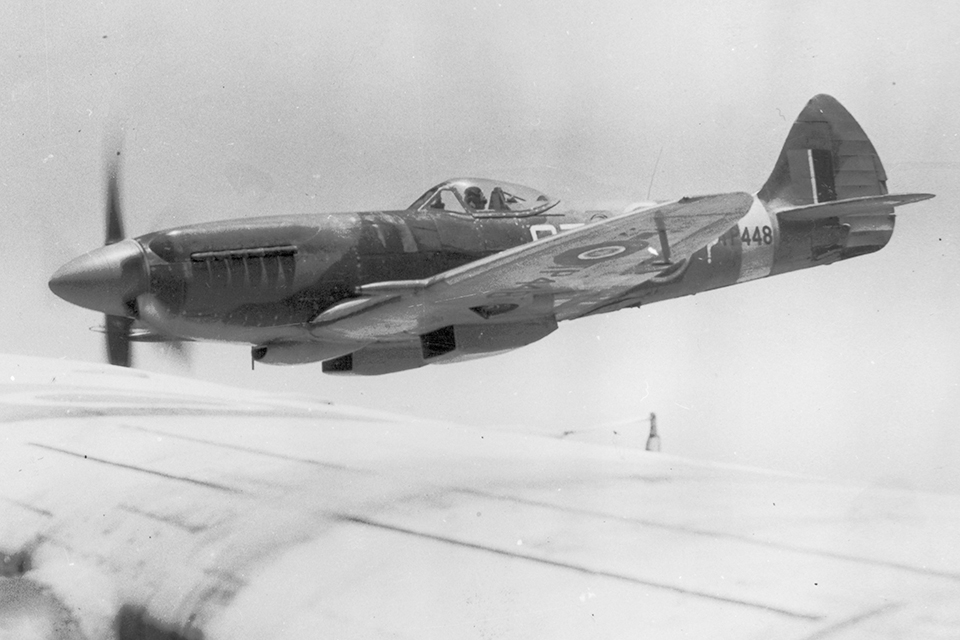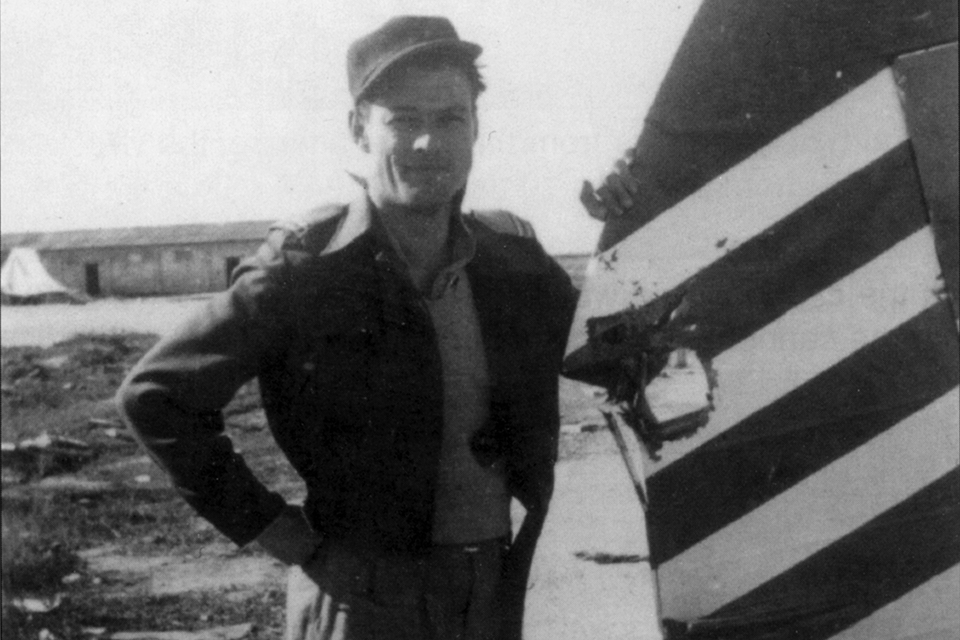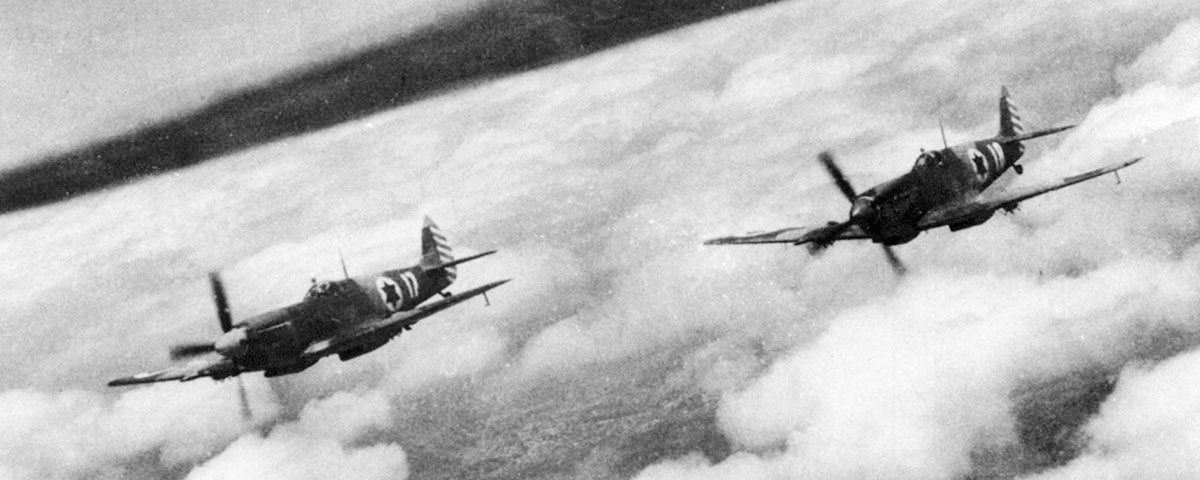Israel’s War of Independence was punctuated by wild aerial engagements that underscored the conflict’s confusing nature.
Around noon on January 7, 1949, two patrolling Israeli Air Force (IAF) pilots in Supermarine Spitfires spotted a column of black smoke rising from the Al-Auja–Rafah area of the Sinai Desert. Getting nearer, they saw an Israeli Defense Force (IDF) motorized column under attack by what they assumed were Spitfires of the Royal Egyptian Air Force (REAF). Although one hostile Spitfire had been shot down by IDF gunfire, three others were still circling. The IAF duo raced to the rescue. Minutes later, all three remaining “hostiles” had been shot down. Except they were not Egyptian.
The IAF pilots realized too late that their adversaries were actually British Royal Air Force (RAF) reconnaissance Spitfires whose pilots had also been attracted by the smoke—confusion that led to the fatal misidentification. Like most things in the Middle East at this time, however, the circumstances were much more complex than at first sight. Not least was the fact that one Israeli Spitfire was flown by a Canadian World War II ace and the other by an American former test pilot, both IAF volunteers who had once served with the British.
The incident occurred on the final day of Israel’s War of Independence. But its origins lay deep in the complex web of Middle Eastern politics that preceded and followed the end of the British Mandate in Palestine at midnight on May 14, 1948, and the recommendation of a U.N. commission that separate Arab and Jewish states should be established in Palestine.
Exhausted by years of continuous warfare and having just relinquished their Indian empire, the British were in no mood to cling to a volatile Middle Eastern territory at the cost of yet more lives. But they needed to organize an orderly withdrawal. The immediate postwar period of the British Mandate from 1946-47 had been far from peaceful, especially for an RAF depleted by massive demobilizations. Moreover, the RAF’s unwelcome task of locating and identifying ships transporting Jewish “illegal” immigrants, mainly Holocaust survivors, for the Royal Navy to intercept, led to its bases being singled out for attack by Jewish militants. A radar station was blown up and weapons were stolen from RAF armories. Then, on the night of February 25-26, 1946, during simultaneous attacks on three RAF bases, Jewish raiders destroyed or damaged 22 Handley Page Halifax bombers, seven Spitfires and four Avro Ansons.
Following these and other attacks, the RAF presence in Palestine had by mid-1947 been reduced to five squadrons, including Nos. 32 and 208 flying Spitfires. Other units had relocated to Cyprus or the Suez Canal Zone. As Arab hostility toward the Jews increased, British forces that had been fully occupied in defending themselves against mainly Jewish attacks also had to intervene in Arab-Jewish conflicts.
Well before the British departure, the Jewish paramilitary organization Haganah had formed an air wing, the Sharut Avir (SA), flying a ragtag assortment of civil aircraft in support of the isolated Jewish settlements. One of its pilots was young Palestine-born Ezer Weizman, who had learned to fly with the RAF but not yet seen combat. Although the British made no serious efforts to interfere with the SA’s activities, they kept a cautious eye on developments.
Meanwhile, anticipating war with their prospective Arab neighbors, Jewish agents and their supporters in the U.S. and Europe were searching for modern aircraft and combat-experienced crewmen, preferably Jewish. Many came forward, including numerous non-Jews, or “Machals,” who volunteered for ideological reasons or because they missed combat.

Instructed by their Soviet masters to rid themselves of Western equipment, the Communist Czech authorities agreed to sell the agents 25 Avia S-199s, Czech-built Messerschmitt Me-109Gs fitted with Junkers Jumo 211 engines instead of the usual Daimler Benz DB 605s (a pairing that resulted in unpleasant flying characteristics and the nickname “Mule”). The Czechs also agreed to train a number of Jewish pilots, Weizman among them. In America Israeli agents purchased four P-51 Mustangs, three B-17s and later a number of North American T-6s that were converted to the attack role, plus an assortment of transport aircraft, initially used to airlift some of the S-199s from Czechoslovakia.
The war with the Arab states of Egypt, Lebanon, Transjordan, Iraq and Syria began immediately after the end of the British Mandate and the declaration of the state of Israel on May 14, 1948. The Arabs had rejected the 1947 U.N. Partition Plan for Palestine that was intended to create Arab and Jewish states side by side. The conflict had several phases, a detailed description of which is outside the scope of this article. Ultimately, with the IAF able to quickly establish air supremacy, Israeli victories on the ground came in swift succession on all fronts, leading to a rapid expansion of the new nation’s territory. Although their main opponents, the numerically superior Egyptians, were British-trained and -equipped, they had no combat experience and never offered serious opposition to the IAF’s veterans.
Meanwhile the soon-to-depart RAF was not immune from the conflict. On the morning of May 22, Egyptian Spitfire LF Mark IXs attacked Ramat David airfield, near the British enclave at Haifa (which the RAF was preparing to evacuate). Two RAF Spitfires were destroyed on the ground and eight others damaged. During a second raid a Douglas Dakota transport was destroyed while landing, killing two crewmen and two airmen. A third REAF attack did little damage, since the RAF had by then mounted a standing patrol of No. 208 Squadron Spitfires over the airfield. Five Egyptian Spits were shot down, one by groundfire, one each by Flying Officers Geoff Cooper and Roy Bowie and two by Flying Officer Tim McElhaw. The REAF later said its pilots had mistaken Ramat David for “the Zionist airfield at Megiddo,” which—as the IAF had yet to acquire Spitfires—suggests the Egyptian fliers were weak on aircraft recognition.
Not that the Israelis weren’t keen to obtain Spitfires. They would eventually rebuild two using parts salvaged from crashed RAF and REAF aircraft. McElhaw recalled an incident at Ramat David when an egg seller from a Jewish kibbutz furtively brought in an offer to the officers’ mess to pay £8,000 to anyone who would fly a Spitfire into Tel Aviv airfield. The plot specified that the pilot would later be taken out to sea, dropped in the water, rescued and returned with a cover story that he had been seen ditching. The pilots were amused by the offer, but there were no takers.
The Israelis eventually got their Spitfires through an agreement with the Czechs in June 1948 to purchase 59 LF Mk. IXs. These ex-RAF aircraft had formed the nucleus of the new Czech air force but for political reasons had to be discarded by 1948. IAF pilots would fly them across Europe to Israel in stages.
Mistaken identity may have been responsible for an Israeli “attack” on RAF Amman on May 31-June 1. Knowing that members of the Arab League were to meet in the Trans-jordanian capital, the Israelis decided to bomb Amman in a show of defiance, using a scratch force comprising a Beech Bonanza, a Fairchild Argus and a de Havilland Dragon Rapide. Their bombs killed six Arab civilians and injured eight others. Whether by accident or design, four crude bombs and three incendiaries exploded within the perimeter of the RAF base, slightly damaging two Ansons but resulting in no casualties. British forces in Transjordan were put on the alert, and a stripped-down Percival Proctor communications aircraft was briefly converted into a “night fighter.”
While bitter fighting continued between Israeli and Arab forces, the RAF sought to monitor developments through reconnaissance flights over the Sinai and Israel using unarmed de Havilland Mosquito PR Mark 34s of No. 13 Squadron, based at Kabrit in the Canal Zone. Suspecting that at least some of the intelligence gained from these flights was being passed to the Egyptians, the IAF made several unsuccessful attempts at interception, failing because they had no aircraft capable of reaching the required altitude—that is, until four P-51Ds arrived in crates from the U.S. in late September. After assembly, these were allocated to the IAF’s Hatzor-based 101 Fighter Squadron, to augment its S-199s and Spitfires.
On November 20, Flying Officer Eric Reynolds and navigator Flight Sgt. Angus Love were assigned to the “Palestine milk run.” Having flown the route several times before, they had no reason to believe it would be anything other than routine. Probably through overconfidence, they stayed well below the PR 34’s maximum altitude of 43,000 feet while heading for Palestine’s northern coast to photograph Israeli airfields. Sighting the Mosquito, 101 Squadron dispatched a P-51 flown by U.S. Army Air Forces combat veteran Wayne Peake, a non-Jewish volunteer. Even though Peake’s oxygen system malfunctioned, he managed to take the Mustang up to 30,000 feet, 2,000 feet above the Mosquito, then fired off a long burst that initially seemed to have no effect. But after turning out to sea and losing altitude, the PR 34 exploded and crashed, killing Reynolds and Love. Back at Hatzor, the oxygen-starved Peake at first claimed he had shot down a four-engine Halifax bomber.
The IAF sent Weizman up in an amphibian to look for survivors, but he found only wreckage. Mosquito overflights were suspended, and RAF intelligence faced angry questions over its failure to register the IAF’s acquisition of fighters that could fly above 30,000 feet.
Israel’s last push of the war, code-named “Chorev,” was conceived in early December 1948 with the objective of finally ousting the Egyptians from the Negev, safeguarding Israel’s southernmost communities and giving the fledgling country an unassailable negotiating position with the Arab nations. The IAF would once again be at the forefront of the offensive, with 101 Squadron deploying five Spitfires, two P-51s and six S-199s.
As Chorev progressed, increasing activity by REAF Spitfires and other aircraft based at El-Arish led the Israelis to undertake a daring commando raid against the airfield and auxiliary landing grounds. At one satellite base they captured an unserviceable Spitfire LF Mk. IX they planned to tow back to Israeli-held territory. Alarmed, the REAF began evacuating their main El-Arish base.

The RAF’s 205 Group, based in the Canal Zone, began monitoring the Israeli advance through photorecon missions flown by Nos. 13 and 208 squadrons over the northern Sinai. Mosquitos of 13 Squadron had recommenced flights over Israel in early December. By the war’s final week, the Egyptians were appealing to the British for assistance. The RAF had already allowed the REAF to use three of its early-warning radar sets, in case the IAF tried to reach Egypt’s heartland. Now the British formally agreed to provide refueling facilities at various RAF airfields in the Canal Zone, and also allow Egyptian aircraft to land if at serious risk. In the meantime, stunned by the speed of the Israeli advance, the British foreign secretary advised his American counterpart that if the Israelis didn’t withdraw from Egyptian territory, the British would take action against them under the 1936 Egyptian Treaty. President Harry Truman demanded that Israeli Prime Minister David Ben Gurion order the Israeli forces to withdraw. After token protests, the Israeli leader instructed the IDF to begin pulling back to the international frontier. But it was not until later that a U.N.-brokered cease-fire was finally agreed to, commencing at 1600 hours on January 7, 1949.
On January 1, meanwhile, RAF Fayid had sent a 13 Squadron Mosquito and two 208 Squadron Spitfires to monitor developments along the front. Four 208 Squadron Spits later photographed the REAF Spitfire captured by the Israelis from El-Arish being towed toward the frontier along the Abu Ageila–Al-Auja road.
A sandstorm on January 6 halted military operations by both sides, but RAF Mosquitos and Spitfires carried out a tactical reconnaissance of the Egyptian-Israeli frontier. The pilots reported considerable activity along the Al-Auja– Rafah road, and 208 Squadron’s commanding officer decided further recon would be needed the following day—setting the scene for tragedy.
Four 208 Squadron pilots were assigned to the mission: Flying Officer Cooper and his wingman, Sergeant Frank Close, and Flying Officer McElhaw and Sergeant Ron Sayers. (Cooper and McElhaw had shot down REAF Spitfires over Ramat David on May 22, 1948.) Their brief was to establish the position of Israeli forces in northeast Sinai by surveying the Al-Auja–Rafah road. Although the pilots were instructed not to cross into Israeli territory, their commanders made it clear that information on the whereabouts of the towed-away REAF Spitfire would not be unwelcome. All the aircraft were fully armed.
Getting airborne from Fayid at 1115 hours on January 7, the Spitfire FR Mk. XVIIIs flew to Abu Ageila, then separated into two sections. Cooper and Close flew at 500 feet, with McElhaw and Sayers providing top cover at 1,500 feet, over an expanse of featureless desert along the border between Egypt and Israel. Their route included a number of turning points where it would have been easy for the formation to penetrate the border—which the RAF pilots almost certainly did during their unsuccessful search for the captured Egyptian Spitfire. They then turned back toward Rafah inside Egyptian territory, heading west to Fayid.
The patrol was unaware that, about 15 minutes earlier near Rafah, five REAF Spitfire LF IXs had strafed an Israeli motorized column, setting three trucks on fire. Sighting the black smoke, the RAF planes veered toward the burning vehicles, Cooper and Close dropping down to near ground level to photograph the scene.
The Israelis in the column, convinced they faced a second wave of Egyptian attackers, opened fire with machine guns, hitting both RAF aircraft. Close’s Spitfire caught fire almost immediately, but he managed to climb to 500 feet and bail out, although his feet caught in the parachute rigging and he landed head first, breaking his jaw. Cooper’s aircraft was less seriously damaged, and he climbed out of immediate danger.
Bewildered, McElhaw and Sayers dropped down to investigate. Also attracted by the smoke were the two patrolling 101 Squadron Spitfire LF IXs, flown by Royal Canadian Air Force ace John McElroy and American Chalmers “Slick” Goodlin, also ex-RCAF and a former U.S. Navy and Bell X-1 test pilot. Sighting the four Spitfires, they assumed these were the REAF airplanes responsible for strafing the convoy. Moreover, since the Israelis almost invariably flew in pairs, it was an IAF operational assumption that any larger grouping must be hostile. As Weizman explained, “If you encountered a foursome they evidently weren’t ours—so shoot ’em up if you can.” Although the IAF Spitfires still had RAF radios and McElroy and Goodlin could hear excited English voices discussing Close’s loss, they failed to connect those transmissions with the incident below. They prepared to attack.
The three remaining RAF pilots evidently did not see the approaching IAF Spitfires, or perhaps had been lulled into a false sense of security by the British-style camouflage and red airscrew spinners similar to their own. Before the British realized the danger, McElroy had fired a burst into Sayers’ aircraft, killing him and downing his Spitfire.
McElroy then turned his attention to McElhaw’s Spitfire. He later said, “I took one look and saw it wasn’t one of ours by the markings, ours had tails painted with big red and white stripes…. so I dropped my sights on him, it was about 400 yards, and I let fly.” His victim recalled: “The first sign I had of trouble was an R/T call [from Cooper], ‘Look out, there’s one behind you!’ I looked out and saw one behind me. That was the end of it. I was simply shot down while orbiting the Close wreckage.” McElhaw bailed out, unhurt.
Goodlin had been pursuing Cooper, who put up more of a fight. The American later wrote: “I could not gain close proximity to the Spit 18 due to the lesser power in my Spit 9. At about 16,000’ the Spit 18 rolled over and dived back towards me at an impossible deflection angle, with machine-guns blazing and exhaust smoke rolling out under both wings.” Taking advantage of his Spitfire IX’s greater maneuverability, Goodlin managed to shoot Cooper down. He recalled, “I only recognized the RAF roundels after the Spit 18 had fired on me, when we were in the scissors engagement and I had no alternative but to fight back to save my own bacon.” (Cooper evaded capture, but McElhaw and Close fell into Israeli hands. They were eventually put on a ship to Cyprus).

After landing, McElroy and Goodlin were greeted with disbelief over their claims to having shot down three RAF Spitfires. Weizman recalled that not everyone was delighted: “These two clowns may have been unperturbed, but we weren’t. We were breathless with agitation. After all, the British are the British. They’re no Egyptians.” But Weizman would soon put his misgivings aside to go into action against the British during a mission originally intended to be a final demonstration of force against the REAF at El-Arish. Four IAF Spitfires participated.
Concerned at having heard nothing from the 208 Squadron patrol, the RAF sent seven Hawker Tempest VIs from 213 Squadron and eight from 6 Squadron to escort four 208 Squadron Spitfires in a search. Over Rafah the RAF formation was observed by Weizman’s four Spitfires, who initially mistook the Tempests for “British Spits” and their underwing drop tanks for bombs. Weizman gave the order to attack. During the confusion of the first pass, volunteer pilot Bill “Sure Shot” Schroeder, an ex–U.S. Navy combat veteran, shot down the 213 Squadron Tempest of Pilot Officer David Tattersfield, who died instantly. Only then did the 213 Squadron pilots realize that their guns, although loaded, had not been cocked by the ground crews.
Seeing the IAF Spitfires attack, four 6 Squadron Tempests— flying top cover under the command of Squadron Leader Denis Crowley-Milling—gave chase, and although their guns fired, they couldn’t jettison their drop tanks (the release pins of the jettison levers had been overtightened). Weizman, meanwhile, had scored hits on a 6 Squadron Tempest flown by Sergeant Douglas Liquorish, but his Spitfire also sustained minor damage after being fired on by Flight Lt. Brian Spragg’s Tempest.
Thanks to their red spinners, which were identical to those of the IAF attackers, the four 208 Squadron Spitfires were in double jeopardy. Flying Officer Roy Bowie of 208 Squadron recalled, “In the melee we were anything but safe as Spitfires were treated as hostile by the Tempests until proven otherwise.”
It was not the RAF’s finest hour. Air Chief Marshal Sir David Lee later described the day’s events as a “dramatic and humiliating confrontation with the Israelis.” The RAF pilots went home vowing revenge. Crowley-Milling remembered, “When we landed back we armed up and begged Headquarters to let us take out the Israeli Air Force at their base.” The IAF pilots likewise prepared to defend themselves. But to the Israelis’ surprise—and to the disappointment of the Egyptians—there was no retribution. The British Foreign Office slapped the Israelis on the wrist with a demand for compensation for the equipment and personnel lost (which was never paid), and the Air Ministry issued a statement that, henceforth, any Israeli aircraft encountered over Egyptian territory would be regarded as hostile by the RAF and dealt with accordingly.
The next day the IAF’s 101 Squadron pilots sent a note to their 208 Squadron counterparts: “Sorry about yesterday, but you were on the wrong side of the fence. Come over and have a drink sometime. You will see many familiar faces.”
At war’s end, when most of the foreign volunteers left the IAF, their departure was unlamented by Ezer Weizman. He noted that their “previous combat experience had always given us the feeling that they looked down on us from a position of superiority, allowing themselves an occasional smile at the ‘natives.’…I’m glad they came when they did, but I’m equally glad they left us to face our problems.” Weizman himself went on to greater things, serving as commander of the IAF from 1958-66 and president of Israel from 1993-2000.
RAF veteran Derek O’Connor, who writes from Amersham, Bucks, UK, is a frequent contributor on British aviation topics. For further reading, he recommends: Spitfires Over Israel, by Brian Cull and Shono Alomi with David Nicolle; Wings in the Sun, by ACM Sir David Lee; On Eagles’ Wings: The Personal Story of the Leading Commander of the Israeli Air Force, by Ezer Weizman; and Fighters Over Israel, by Lon Nordeen. A documentary about the IAF’s birth, Above and Beyond, is currently appearing at film festivals and will premiere nationwide early next year (see the trailer at playmountproductions.com).
Originally published in the November 2014 issue of Aviation History. To subscribe, click here.





